Healthy watersheds throughout the Northwest are critical for plants, animals, and humans. They provide clean water, critical habitat, and places to enjoy nature. In the Gifford Pinchot National Forest, creeks and rivers play an important ecological and social role and provide habitat for salmon and other wildlife. The aquatics team on the Gifford Pinchot National Forest, and partners such as the Cowlitz Indian Tribe, are working to reverse past damage to these watersheds. At the same time, they are preparing for climate change. This work will be important for years to come.
Reading Time | 8 minutes
Management Goals | Restore and rehabilitate watersheds with climate change in mind to build watershed resilience.
Project Leads | Kate Day; Joshua Jones
Project Area | Yellowjacket, Camp, Cispus, and Dry Creeks and Wind River Headwaters
Agency | USDA Forest Service, Gifford Pinchot National Forest
Funding Sources | See funding section
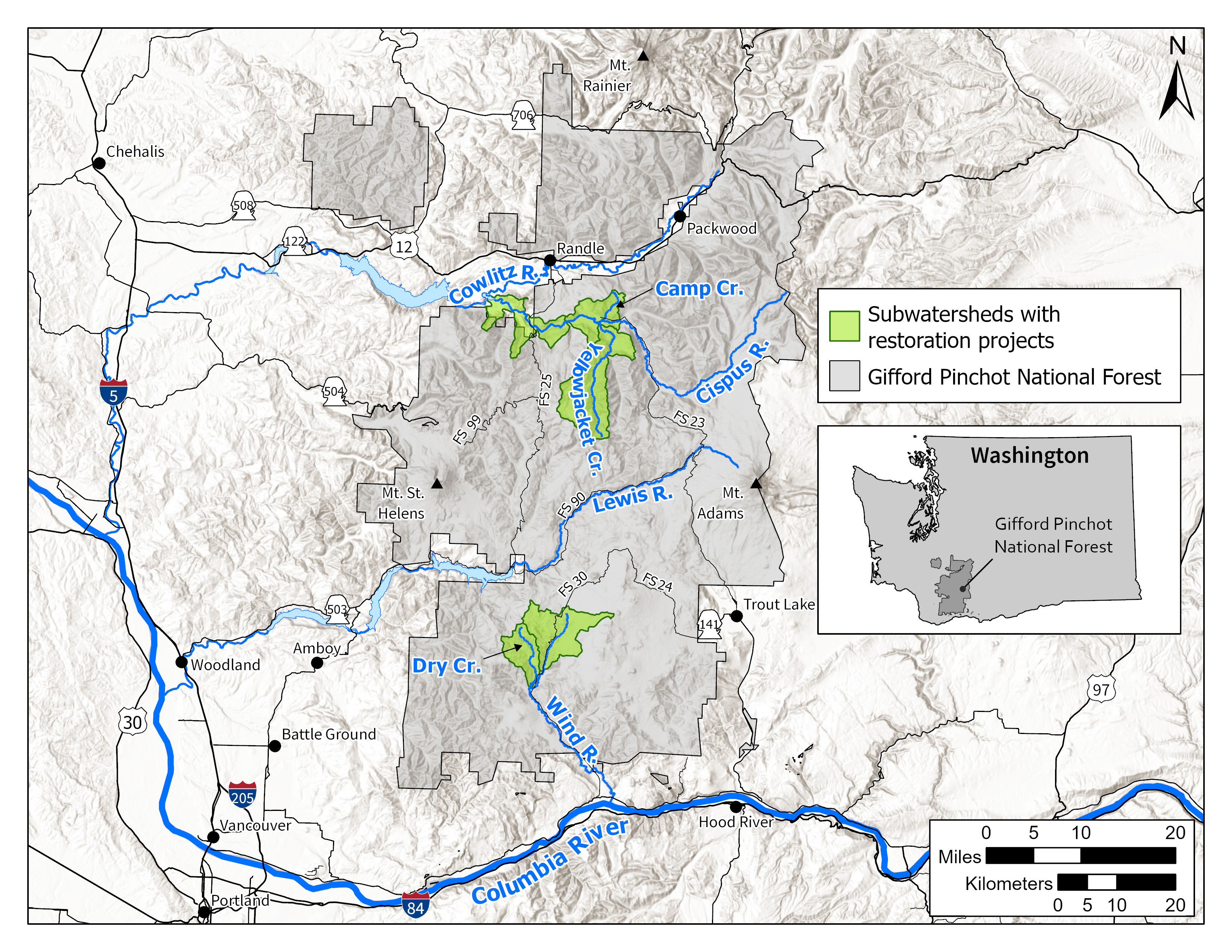 A map of the Gifford Pinchot National Forest and the subwatersheds in the Watershed Restoration Action Plans (WRAPs). Map made by Wes Hoyer, USFS
A map of the Gifford Pinchot National Forest and the subwatersheds in the Watershed Restoration Action Plans (WRAPs). Map made by Wes Hoyer, USFS
In southwestern Washington, the Gifford Pinchot National Forest includes the iconic volcanoes of Mount Adams and Mount Saint Helens, dense old-growth forests, and a wealth of water. Rivers and streams, like Yellowjacket Creek, Camp Creek, Cispus River, Dry Creek, and the Wind River Headwaters, provide important habitat for many animals and clean water to downstream communities. People from nearby cities like Vancouver and rural communities like Carson rely on the forest for recreation and jobs.
These rivers and creeks are also the birthplace and spawning grounds for fall Chinook, summer and winter steelhead, chum salmon, coho salmon, and coastal cutthroat trout. Many of these fish are listed as threatened or endangered under the Endangered Species Act. Salmon health is dependent on good habitat. In turn, a healthy salmon fishery affects the local economy. Salmon are also a key element of the culture of the Cowlitz Indian Tribe, who took care of this land historically. The Cowlitz Indian Tribe’s knowledge and understanding of how these watersheds worked before modern-day disturbance is key to helping these rivers, streams, and wildlife recover from past damages.
Since the late 1800s, humans have changed these rivers. This has made water flow through them faster, damaged or removed places where fish can spawn and find refuge, and decreased their ability to regulate both high and low flows. Historical activities in these watersheds (logging, mining, stream cleaning, diking, hydropower, and human development) degraded streams and fish habitat. Others, such as bridge and road building, led to permanent changes to floodplains and increased sediment buildup. Stand-replacing fires in the early 20th century in Yellowjacket and Cispus Creeks also reshaped the landscape. Because of these historical changes, the streams and rivers in the Gifford Pinchot National Forest are less able to recover from stress from extreme weather events and climate change.
According to Kate Day, former watershed program manager for the Gifford Pinchot National Forest, “We have so much [human] disturbance in these systems―people pulled logs up streams, cleaned sediment out of streams, removed all the downed wood, and constructed roads adjacent to streams―that we’ve created a system where things are very out of whack. Once a system is disturbed to a certain point, it is more difficult for it to naturally rehabilitate itself, so it requires some intervention from us.”
Watershed restoration can help to reverse past damage and prepare watersheds for a changing climate. The Forest Service has a process by which watershed quality can be prioritized based on the “ecological, hydrological, and geomorphic functions and processes that affect watershed condition,” called the Watershed Condition Framework. Since 2009, the Forest Service has used this framework to evaluate watershed condition and to plan and execute watershed restoration projects. National forests use this framework to develop Watershed Restoration Action Plans (WRAPs) for watersheds that are priorities for restoration. The Forest plans to work on the restoration projects in the WRAPs over the next 5–7 years to improve watershed conditions and increase resilience to climate change.
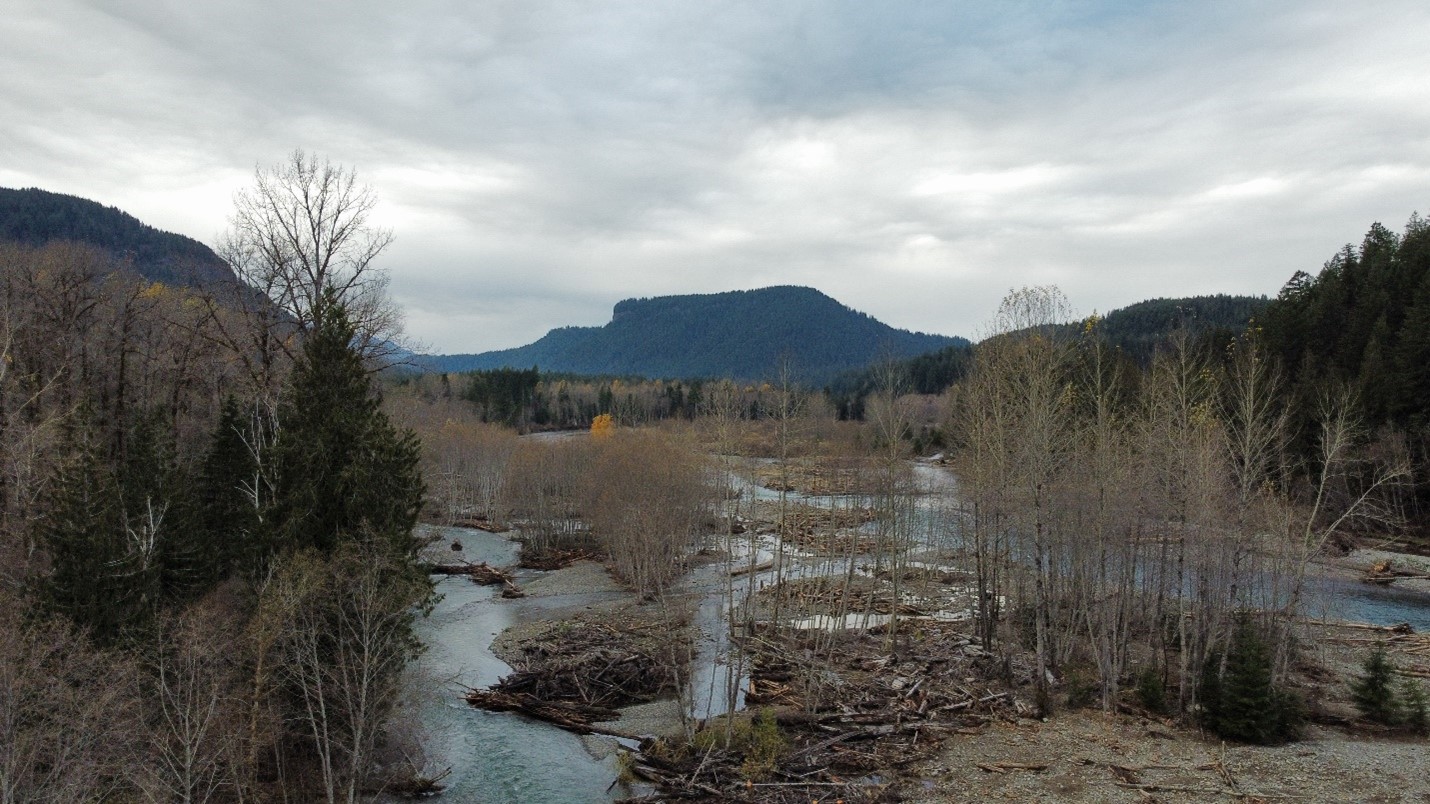 Restoration can help recreate side channels, reconnect the floodplain, and spread water out to increase infiltration during both high and low flows. Credit: Cowlitz Indian Tribe
Restoration can help recreate side channels, reconnect the floodplain, and spread water out to increase infiltration during both high and low flows. Credit: Cowlitz Indian Tribe
The Gifford Pinchot’s WRAPs align with the Forest Service’s recently released Climate Adaptation Plan. The plan identifies extreme events (e.g., flooding, extreme rain, and landslides) and chronic stressors to watersheds (e.g., shifts in seasonal precipitation, growing season length, and minimum and maximum temperatures) as some of the most challenging issues the agency faces in the future. It points to climate-informed watershed restoration as an important way to respond to these changes. More locally, the Forest Service’s climate change vulnerability assessment for Southwest Washington notes that restoration activities that help watersheds store more water will help forests prepare for climate change.
While managers have considered climate change in watershed restoration plans for many years, the Gifford Pinchot National Forest’s WRAPs are more explicit in their planning. These WRAPs are some of the first to integrate effects of climate change on streamflow and temperature, offering useful examples for other national forests in the region and around the country.
The aquatics team saw repairing past damage as an opportunity to plan for climate change and help stream systems be more resilient to future changes. Including climate change in planning allows planners to understand where vulnerabilities are and helps to prioritize projects within a watershed. Day says, “We really need to consider [climate change] because we don’t have unlimited money, so it’s one more tool to inform our choices.”
Climate Change Impacts of Concern
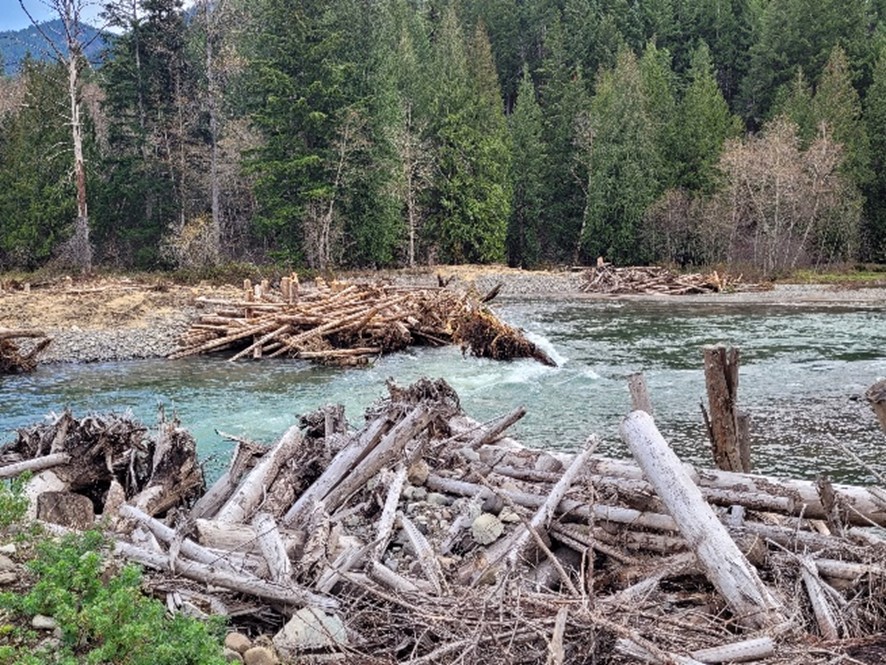 Log jams in the Gifford Pinchot National Forest after 2021 floods. Credit: Cowlitz Indian Tribe
Log jams in the Gifford Pinchot National Forest after 2021 floods. Credit: Cowlitz Indian Tribe
Climate change is already happening, but future threats to these watersheds with climate change will only continue to increase. As the Northwest warms, precipitation patterns will change. More precipitation will fall as rain rather than snow, which will lead to more wintertime flooding. Kate Day also mentions that precipitation variability is increasing on the Gifford Pinchot National Forest. Stronger storms generate higher peak flows, but fewer storms occur at times of year when the region would have normally seen more moisture. These changes will affect streamflow timing, causing higher high flows in the spring, fall, and winter, and lower low flows, especially later in the summer. Changes to flow will alter habitat for salmon and other animals that rely on these rivers, and result in flooding damage to roads and infrastructure.
Day says that “across the board, we’re seeing snowpack melt off earlier than it did historically. This puts water in the system earlier, and then it flows through that system quickly.” This means that when temperatures are the highest in the summer, flows will be lower than they were historically.
This combination of lower low flows and higher high flows poses challenges for rivers that are already damaged from years of misuse. Higher high flows will cause more erosion, block or destroy culverts, wash out more roads, and put more sediment into the system. Lower low flows mean that water temperatures will be higher, increasing as much as 3.8°F by 2080. Fish that rely on cool stream temperatures will struggle to survive during these warmer summers. Low flows can also fragment water-based habitat, making it difficult or impossible for fish and other animals that rely on flowing water to move throughout streams.
The work being done by the Gifford Pinchot National Forest and partners will build resilience for future variation in streamflow. Because many of the streams will see both higher high flows and lower low flows, systems are needed that will both allow for water to get through the system without causing damage and hold water in systems longer.
In Dry Creek and Wind River Subwatersheds, stream restoration and infrastructure improvement projects will build resilience to projected changes in flow. In the Yellowjacket and Camp Creek Subwatersheds, the Gifford Pinchot National Forest and its partners are targeting restoration projects to improve stream function to build resilience to lower low flows. To be prepared for higher high flows, they plan to improve culverts to both reduce the chances of failure and allow for fish and other wildlife to continue to pass through at both high and low flows.
Many of the projects will reduce risks associated with flooding by slowing water down and spreading it out. Because the current road system is threatened with higher high flows, infrastructure improvements will help reduce future risks to the road system (described in detail in the next section). These projects will also create better functioning watersheds and lower stream temperatures.
Adaptation and Implementation
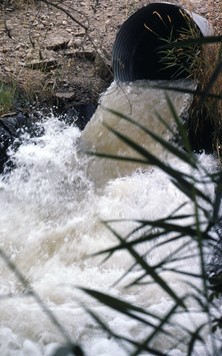 Inappropriately sized or placed culverts can block fish passage during high and low flows. They can also act as a fire hose during high flows, scouring out the stream below them. Credit: NRCS Montana
Inappropriately sized or placed culverts can block fish passage during high and low flows. They can also act as a fire hose during high flows, scouring out the stream below them. Credit: NRCS Montana
To implement these projects and plan for climate change, the Gifford Pinchot National Forest put together Watershed Restoration Action Plans (WRAPs) for each watershed. The Cowlitz Indian Tribe, a key partner, provided much of the funding and has begun implementing some of the projects. Implementation has focused on improving stream quality and fish habitat, reducing risks during high flows, and making it easier for fish and other aquatic life to use rivers during times of low flow. So far, they have restored 0.8 miles of stream, planned and designed three passages that will help aquatic life move more easily, and will restore an additional 2.2 miles of stream in early 2023.
Road systems on national forests provide access for recreationists and managers. Unfortunately, with increased flooding risks, roads are more likely to wash out and present risks to animal habitat and people. To address this, managers are working to remove unnecessary roads, stabilize roads that cannot be removed, relocate roads farther away from stream banks, and replacing culverts. Incorporating climate change into their WRAPs allowed the aquatics team to identify and focus on roads and culverts that would be more vulnerable to climate change, which is something that other national forests in Washington are also exploring.
Kate Day says, “We have some culverts that may not be providing the best fish passage, but they are appropriately sized from a climate change perspective. Those are the types of projects we can put lower on the priority list because they’re already resilient. Even though they’re not perfect, we have a lot of other projects that our climate change assessments have shown to be a much higher priority.” Considering climate change also allows them to see where critical fish habitat will be in the future. This can help ensure that fish will have access to those parts of the river as flows change.
Higher streamflow and more intense rainstorms can lead to road washouts, especially when roads are located on or near steeper slopes or next to streams. These can affect roads of all sizes, from single lane forest roads to highways. This type of failure during high flows was apparent in the 2022 floods in Yellowstone National Park, neighboring national forests, and communities. Locally in the Pacific Northwest, intense rainstorms during the La Niña winter of 2021–2022 also led to challenges, including substantial road damage on the Olympic National Forest when a November atmospheric river brought 10 inches of rain in a 4-day period, and a January rain-on-snow event triggered landslides that shut down I-84 in the Columbia River Gorge. These types of events may become more common as the climate continues to warm, with higher ocean temperatures resulting in more intense atmospheric river events and a higher likelihood of damaging flooding.
In addition to their impacts on communities and infrastructure, road failures can lead to an influx of sediment in streams. Sediment can hurt the gills of fish, block young salmon from emerging from their redds (salmon gravel “nests”), and increase parasites in redds. Day says that it also “can result in a channel that is no longer passable, which cuts off habitat. [Road failures] wash out riparian areas as well. Small road failures high up in a watershed can have a cascading effect lower down into the watershed, kind of like an unraveling process.”
Removing roads from active use (decommissioning) and moving them away from riparian areas also allows plants to return next to streams and rivers. This creates shade over exposed streams, which cools the water. Strategically placed riparian vegetation can reduce water temperature enough to prevent future temperature increases in some situations.
For both high and low flows, the team in the Gifford Pinchot National Forest is putting large wood in the rivers, reconnecting side channels, and creating grade-control structures (watch this short video to see how grade control structures help stabilize rivers during high flows). One benefit from this work for low flows will be that streams will hold water longer. Large wood creates structures that form deep pools, and side channels reconnect the river to its floodplain. This allows more water to infiltrate into the ground, increases base flows (portion of the stream flow that remains constant between precipitation events), and provides cool water. During high flows, deep pools protect fish, and large wood and reconnected side channels slow water down. They spread water out to a larger area, which increases infiltration and reduces future flood risks.
For sensitive animals like salmon, being able to move freely through a river system will help them find cold water refugia as temperatures increase. Also, as climate change affects salmon, it will be important that fish reproduce in as many places as possible, thus increasing the survival of young fish. This will lead to a larger, healthier, and more resilient population.
Challenges and Opportunities
Many of the management actions used in these Gifford Pinchot National Forest projects are typical of watershed restoration projects. This means that adapting watersheds to climate change does not necessarily require new management approaches. However, by incorporating climate change into the WRAP process, the Gifford Pinchot National Forest is able to prioritize limited resources to purposefully plan for a future in which the streams and rivers flow differently than they did in the past.
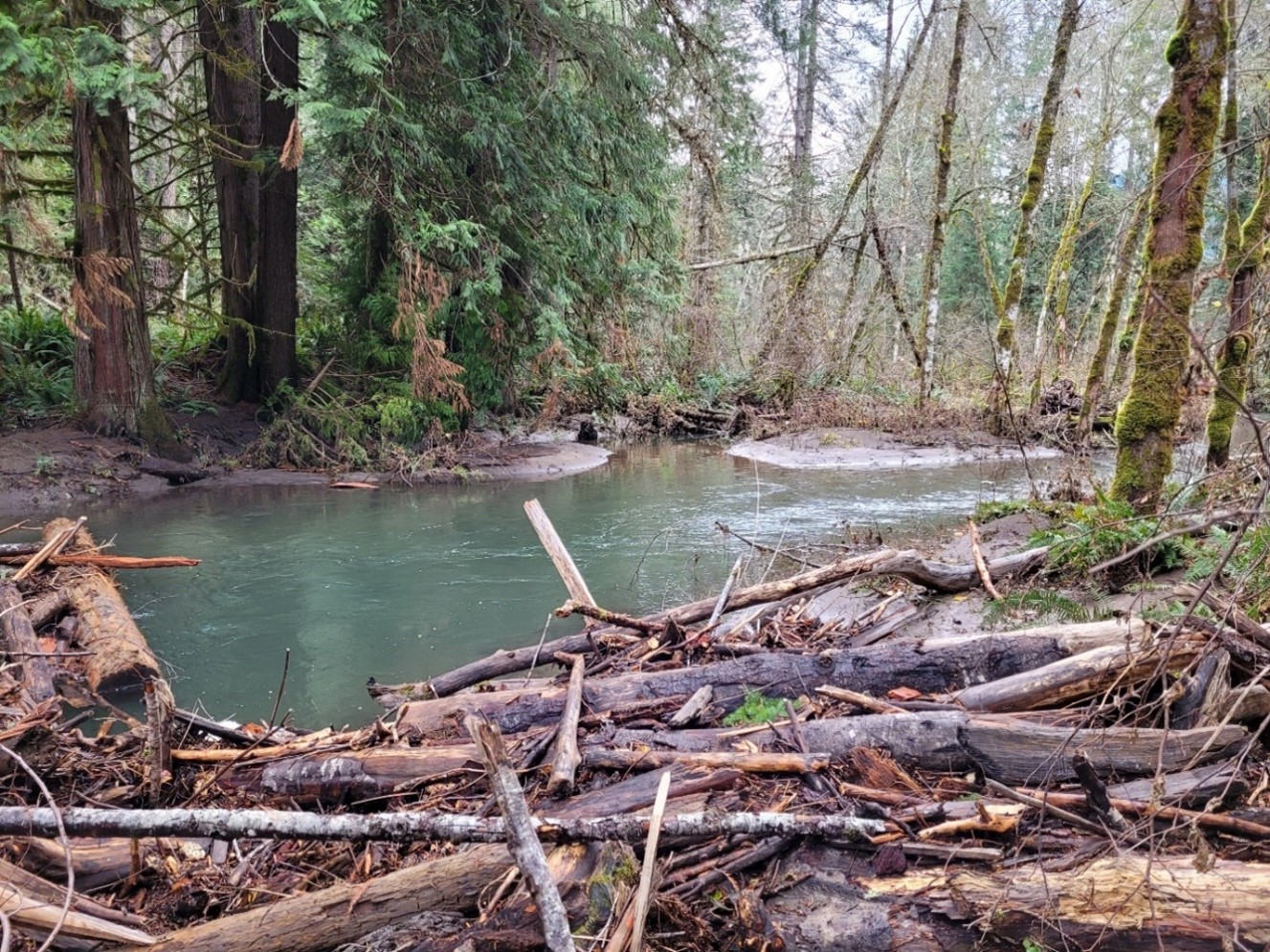 Log jams can be created when large wood is is added into streams. This, in turn, forms deep pools that protect fish, other aquatic life, and reduce downstream flooding risks during high and low flows. Credit: Cowlitz Indian Tribe
Log jams can be created when large wood is is added into streams. This, in turn, forms deep pools that protect fish, other aquatic life, and reduce downstream flooding risks during high and low flows. Credit: Cowlitz Indian Tribe
The aquatics team of the Gifford Pinchot National Forest and partners saw an opportunity to make big impacts in parts of the river system where historical damage was high. Because of historical stream cleaning (removing wood from streams), many streams are channelized. Small efforts like putting wood into rivers can create more complex habitat with large pools and side channels. Day says, “A lot of these subwatersheds have substantial projects that aren’t a huge lift to get big benefits. There is some low-hanging fruit where we can make a big difference right away in the Dry Creek subwatershed as well as in the headwaters of the Wind River. Those stream systems have no large wood at all, and water is just churning through with nothing to slow it down. We can put wood into those systems and see immediate changes for a relatively low cost using trees from the national forest.”
Using wood directly from the riparian area creates another opportunity. Day says, after carefully assessing the composition of riparian stands, “we can promote more old-growth characteristics by taking out some of those riparian trees and putting them directly into the stream system. Carefully selected trees can open the riparian area to encourage other trees to grow older and larger over time.”
Day emphasized that the partnership with the Cowlitz Indian Tribe has been important to the success of these projects. The Tribe’s ecological knowledge of these rivers and streams has helped to plan restoration projects that will provide the most benefit to salmon and other wildlife. The cultural significance of salmon to the Tribe means that they are deeply invested in the success of these projects, and they have provided substantial support to the national forest. They also acquired funding that the Forest Service would not have been able to access. In return, the Tribe was able to work under the Gifford Pinchot’s programmatic permits and reduce the number of agency approvals. Day mentioned that finding funding without the help of the Cowlitz Indian Tribe has been a challenge. Some of the funding the Forest Service was hoping for did not come through, which may delay the implementation of some projects in their WRAPs.
Funding programs in the Bipartisan Infrastructure Law may help to support more watershed restoration on national forests in the future. The Legacy Roads and Trails program provides funding for national forests to improve roads and trails, thereby reducing risks of sediment entering streams when roads and trails wash out. The Collaborative Aquatic Landscape Restoration Program also provides an opportunity for national forests to work with partners to improve watershed habitat and conditions.
The biggest challenge with incorporating climate change into the WRAPs was the time commitment. Day said that, for someone unfamiliar with the tools, it could add about a week of work to take climate change into consideration. However, she emphasized that the benefits of incorporating climate change were worth the extra time. She noted that there are several resources available to make planning more efficient (see resources below) and encouraged Forest Service personnel who are unfamiliar with climate change to reach out to their regional office hydrology and climate change programs for support. In the Pacific Northwest Region, the Data and Resource Management (DRM) team can also help users unfamiliar with working with geospatial data on climate change get started on the process.
- Gifford Pinchot National Forest
- Climate change and forest management on federal lands in the Pacific Northwest, USA: Managing for dynamic landscapes
- Riparian vegetation shade restoration and loss effects on recent and future stream temperatures
- While the partnership between the Cowlitz Indian Tribe and the Gifford Pinchot National Forest did not use Section 638 Authority under the Indian Self-Determination and Education Assistance Act of 1975, this authority is being used elsewhere in the region by Tribes working with national forests
- Hudec, Jessica L.; Halofsky, Jessica E.; Peterson, David L.; Ho, Joanne J., eds. 2019. Climate change vulnerability and adaptation in southwest Washington. Gen. Tech. Rep. PNW-GTR-977. Portland, OR: U.S. Department of Agriculture, Forest Service, Pacific Northwest Research Station. 249 p.




